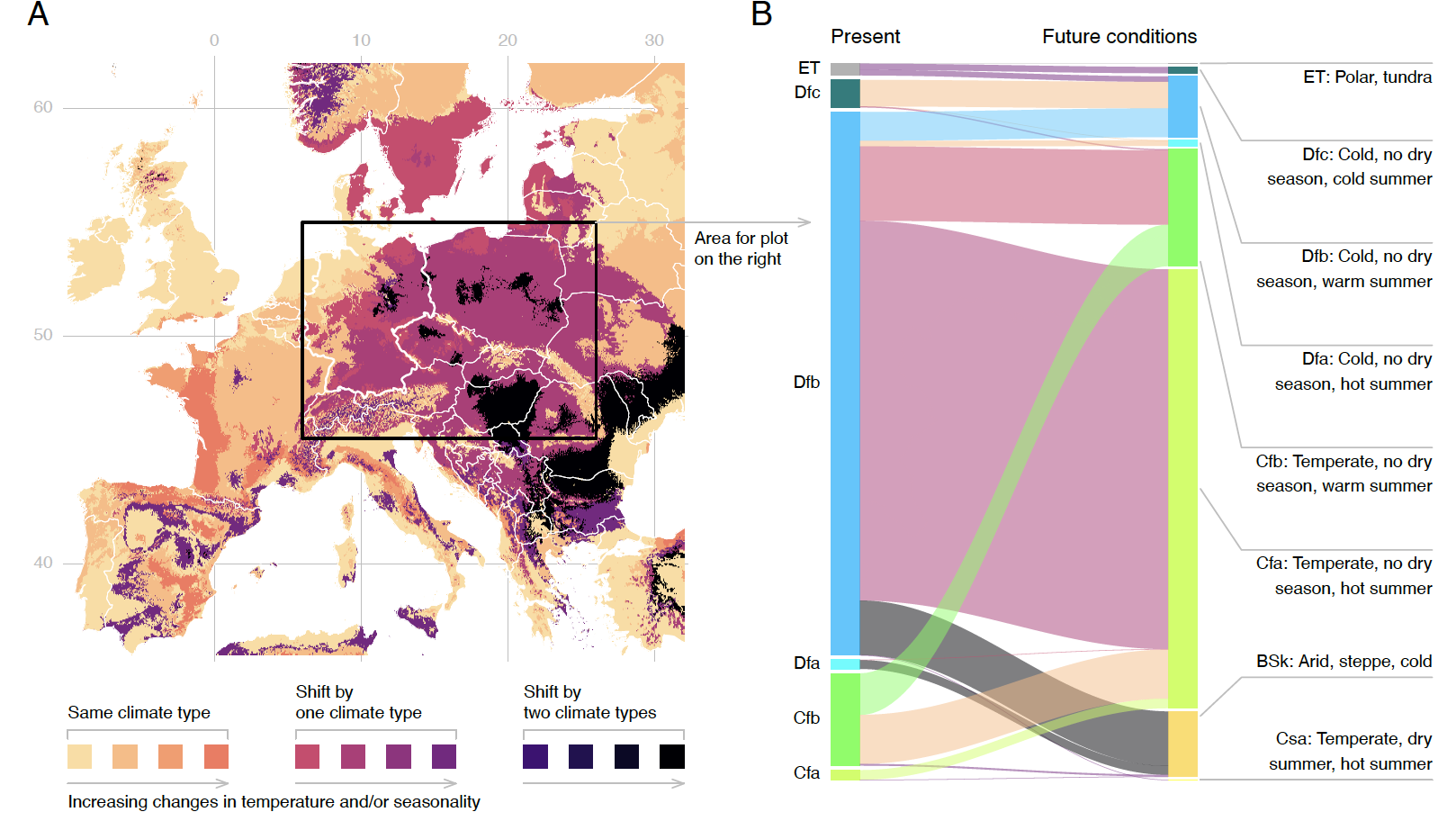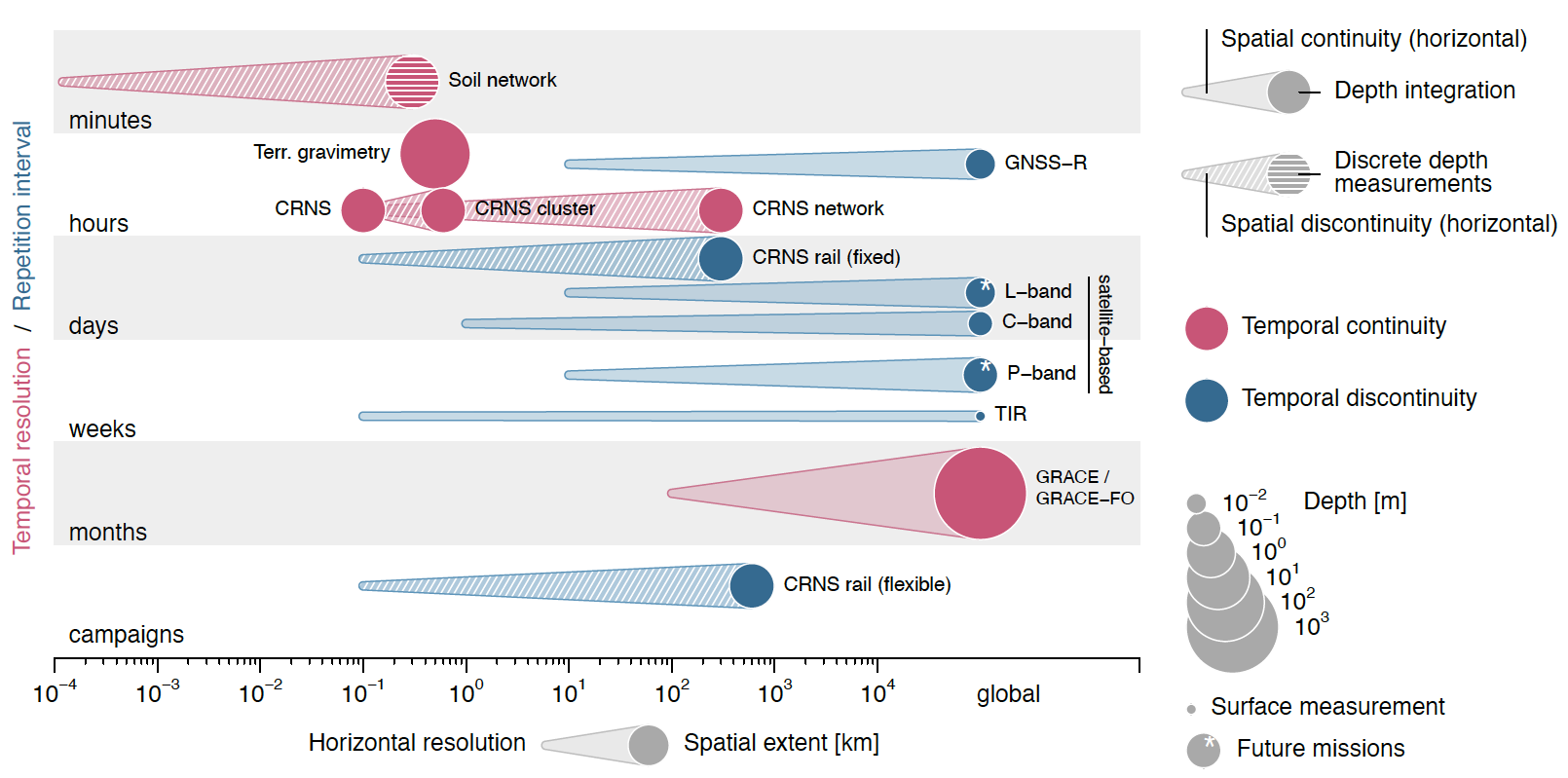Soil water storage
Current forecasts predict a strong increase in temperature for central Europe, leading to substantial shifts in the prevailing climate with strong impact on the water balance. Since monitoring and a thorough understanding of the underlying processes are crucial for adequate management of water resources, a group of around 20 scientists gathered to brainstorm and elaborate on how to improve the observation of the subsurface water storage in central Europe, based on current developments in measuring and modelling techniques. I had the honor to be part of this group of excellent minds and to coordinate the effort.
The group published a commentary in Hydrological Processes, urging the scientific community to work towards integrating established and novel observational products using models and machine learning to compile hyper‐resolution (sub km) integrated estimates of landscape water dynamics. I was in charge of creating the figures for the commentary which are shown below along with the abstract.
Hydrology on solid grounds?
Knowledge gaps in our understanding of soil- and groundwater dynamics across Europe
Figure 1

Future climate class change in Central Europe. On the left (A): scoring between present‐day and degree of change predicted for end of century based on Köppen‐Geiger climate classification; adapted from Beck et al. (2018, 2020). The scoring for each 1 km² pixel was based on a change of climate group (capital letter) to a neighbouring one giving 1 point, a change of more than one climate group giving 2 points, a change in seasonal precipitation type (first small letter) giving 0.5 point and a change only of the heat level (second small letter) giving 0.25 point. On the right (B): transformation of all pixel areas [1 km²] from its current to its future class as migration plot.
Figure 2

Spatial and temporal resolution and scales of methods for observing soil moisture or subsurface water storage as field‐scale average or above. Remote sensing observations are grouped together by bands, including active and passive ones. Derived products combining different observations or observations and modelling approaches are not shown. Terrestrial gravimetry could also be installed as a network, but is not included as it has not yet been implemented, opposed to CRNS.
The full commentary is available here:
Hydrology on solid grounds? Knowledge gaps in our understanding of soil- and groundwater dynamics across Europe Sascha E. Oswald, Lisa Angermann, Heye Bogena, Michael Förster, Almudena García-García, Gunnar Lischeid, Eva N. Paton, Daniel Altdorff, Sabine Attinger, Andreas Güntner, Andreas Hartmann, Harrie-Jan Hendricks Franssen, Anke Hildebrandt, Birgit Kleinschmit, Rene Orth, Jian Peng, Masahiro Ryo, Martin Schrön, Wolfgang Wagner, Thorsten Wagener
Hydrological Processes, 2024; 38:e15320
Abstract
Individual approaches to observe water dynamics across our landscape, from the land surface to groundwater, are many though they individually only provide glimpses into the real world due to their specific space‐time scales. Comprehensive integration across all available observations is still largely lacking, limiting both our ability to reduce scientific knowledge gaps, and to guide land and water management using the best available scientific evidence. We argue that a stronger focus on integration of observational products, while utilizing machine learning and accounting for current perceptual understanding, is urgently needed to overcome this limitation. Since Europe is warming faster than any other continent, central Europe is undergoing a dramatic hydro‐climatic transition about which such integrated observations would provide timely and valuable insights. Here we present potential and gaps of current and planned observational methods. We argue that hyper‐ resolution (sub km) integrated estimates of landscape water dynamics are feasible, which could significantly improve our ability to simulate vadose zone and groundwater dynamics. Ultimately closing gaps in our current perception of hydrological processes in a temperate region under strong influence from climate change. We close by arguing that an interdisciplinary effort of various scien‐ tific communities is needed to enable this advancement.
